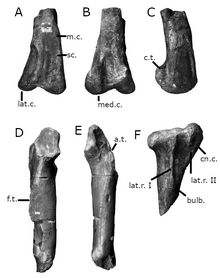Dornraptor
| Dornraptor Temporal range: LateSinemurian,[1]
| |
|---|---|

| |
| Known fossil material | |
| Scientific classification | |
| Domain: | Eukaryota |
| Kingdom: | Animalia |
| Phylum: | Chordata |
| Clade: | Dinosauria |
| Clade: | Saurischia |
| Clade: | Theropoda |
| Clade: | Averostra |
| Genus: | †Dornraptor |
| Species: | †D. normani
|
| Binomial name | |
| †Dornraptor normani | |
| Synonyms | |
Dornraptor(meaning "Dorset robber or thief" ) is an extinct genus ofaverostran,possiblystemtetanuran,theropod dinosaur from the EarlyJurassic(LateSinemurian) ofCharmouth,Dorset,England. The genus contains asingle species,D. normani,known from a fragmentary knee joint and femur that were initially described bySir Richard Owenas belonging to the early armored dinosaurScelidosaurus.[5]Dornraptorlived in what is now England, along other theropods likeDracoraptorandSarcosaurus.
Dornraptorwas described as having come from theBlue Lias Formationin 2024, although previous authors proposed a corrected locality of theCharmouth Mudstone Formation.[1]
History of discovery
[edit]
In 1858,Richard Owenreceived fragmentary dinosaur leg bones discovered by James Harrison inCharmouth,Dorset.These included a right knee joint—comprising the articulated distal end of thefemurand a proximal third of thetibiaandfibula—and a partial left femur. He used them as part of the type material of the thyreophoranScelidosauruswhen describing it in 1859.[5][6]Subsequent studies reconsidered their classification, suggesting early theropod affinities within the Saurischia, rather than an early thyreophoran within the Ornithischia.[2]
Theinformal name"Merosaurus newmani"was coined bySamuel Paul Welles,H. P. Powell, and Stephan Pickering in 1995 in an unpublished manuscript for the theropod material.[3][4][7]Carrano and Sampson (2004) proposed that the articulated knee joint likely belonged to a basal, indeterminate tetanuran theropod.[8]Darren NaishandDavid Martill(2007) also assigned these specimens to the Tetanurae.[9]In 2010, Roger Benson suggested that the bones could be attributed to theCoelophysoidea,while ultimately concluding that both specimens were indeterminate theropods.[10]

In 2024,Dornraptor normaniwas formallydescribedas a new genus and species of averostran theropod by Matthew G. Baron. He establishedNHMUK(BMNH) 39496, the right knee joint, as theholotypespecimen. The partial fibula originally described by Owen as belonging to this specimen has since been lost.GSM109560, the left femur, was also referred to the genus. Thegeneric name,Dornraptor,combines "Dorn", an abbreviated form of theAnglo-SaxonDornwaraceaster—referring to the English region of Dorset—with theLatinword "raptor", meaning "robber" or "thief", which is frequently used in the names of small- and medium-sized theropods. Thespecific name,normani,honours British palaeontologistDavid B. Norman.[2]
Description
[edit]
Dornraptorstands out from other theropods due to a large scar along themedialside of thedistalend of the femur, a medial distal crest, and a prominentanterior trochanterseparated from the head by a cleft. Additionally, it possesses a shallow trochanteric shelf and aforamenon the anterior surface of the femur. Its femur also features a deep anteriorsulcusbetween the articularcondylesand a medial condyle with similaranteroposteriordiameter to the width of the articular surface.Dornraptorexhibits an elongatedcnemial crestreaching proximally beyond the medial and lateral condyles, along with a pronounced fibular crest extending up to the proximal end of the tibia. Thelateralside of the tibia also displays a sharp crest parallel to the fibular crest, forming a distinct bulge distally. Additionally, the proximal end of the tibia shows a separate crest, not connected to the fibular crest, and a noticeable cleft between the posterior condyles. Lastly, the lateral condyle of the tibia forms an acute angle when viewed from the medial side.[2]
Classification
[edit]Early reviews of the fossil material suggestedcoelophysoid,tetanuran,andceratosaurianaffinities.[10][8][9]
While specimens NHMUK 39496 and GSM 109560 lack anatomical overlap, their discovery in the same stratigraphic unit, along with similar size and proportions, suggests they belong to the same taxon, distinct from earlier forms and contemporaneous taxa likeDracoraptorandSarcosaurus.Utilizing a modified version of the Baron et al. (2017)phylogeneticdataset,[11]Dornraptorwas found to be an early-branchingaverostrantheropod in a polytomy withElaphrosaurus,Cryolophosaurus,and the clade containingAllosaurusandPiatnitzkysaurus.This clade was recovered as thesister groupto a clade containing theceratosaursEoabelisaurusandCeratosaurus.These results are displayed in thecladogrambelow, withDornraptorand the contemporary non-averostransDracoraptorandSarcosaurusinbold:[2]
ScoringDornraptorin other matrices also resulted in its placement in variousbasalpositions within the Averostra, outside of the major cladesAbelisauroideaandCoelurosauria.[2]
Following the formal description ofDornraptor,Mickey Mortimer discussed it on the Theropod Database blog, noting that some of the characters used by researchers to exclude tetanuran affinities for the holotype are found in some basal members of this clade, such asChuandongocoelurus,Dubreuillosaurus,andEustreptospondylus.One definitive feature—the bulbous fibular crest—supportsDornraptoras a tetanuran, as it is found in genera includingMegalosaurus,Piatnitzkysaurus,andSinraptor.The referred femur is similar toDilophosaurusLiliensternus,ceratosaurs, and tetanurans, suggesting it either comes from a gracile ceratosaur or a tetanuran.[12]
References
[edit]- ^abChoiniere, Jonah N.; Wills, Simon; Bennett, S. Christopher; Barrett, Paul M. (2020). "A small theropod dinosaur from the Lower Jurassic Lias Group of Charmouth, Dorset".Proceedings of the Geologists' Association.131(6): 751–757.doi:10.1016/j.pgeola.2020.08.003.ISSN0016-7878.
- ^abcdefBaron, Matthew G. (2024-04-29)."A new name for old bones: A reassessment of Early Jurassic theropod remains from Dorset, England".Palaeontologia Electronica.27(1): 1–12.doi:10.26879/1346.ISSN1094-8074.
- ^abPickering, S. (1995a). Jurassic Park: Unauthorized Jewish Fractals in Philopatry. A Fractal Scaling in Dinosaurology Project, 2nd revised printing. Capitola, California. 478 pp.
- ^ab Pickering, S. (1995b). An extract from: Archosauromorpha: Cladistics and osteologies. A Fractal Scaling in Dinosaurology Project. 11 pp.
- ^abOwen, Richard (1859). "Palaeontology. Encyclopaedia Britannica, Edition 8".Encyclopædia Britannica.17(1): 91–176.
- ^Owen, Richard(1861). "Monographs on the British Fossil Reptilia from the Oolitic Formations. Part First, ContainingScelidosaurus HarrisoniiandPliosaurus Grandis".Monographs of the Palaeontographical Society.13(56): 1–14.doi:10.1080/02693445.1861.12027929.ISSN0269-3445.
- ^Mortimer, M (2004)"The Theropod Database"Archived2013-09-29 at theWayback Machine.University of Washington. Retrieved 2007-07-04.
- ^abCarrano, Matthew T.; Sampson, Scott D. (2004-09-27). "A review of coelophysoids (Dinosauria: Theropoda) from the Early Jurassic of Europe, with comments on the late history of the Coelophysoidea".Neues Jahrbuch für Geologie und Paläontologie - Monatshefte.2004(9): 537–558.doi:10.1127/njgpm/2004/2004/537.ISSN0028-3630.
- ^abNaish, Darren; Martill, David M. (2007). "Dinosaurs of Great Britain and the role of the Geological Society of London in their discovery: basal Dinosauria and Saurischia".Journal of the Geological Society.164(3): 493–510.doi:10.1144/0016-76492006-032.ISSN0016-7649.
- ^abBenson, Roger B. J. (2010-03-15). "The osteology ofMagnosaurus nethercombensis(Dinosauria, Theropoda) from the Bajocian (Middle Jurassic) of the United Kingdom and a re-examination of the oldest records of tetanurans ".Journal of Systematic Palaeontology.8(1): 131–146.doi:10.1080/14772011003603515.ISSN1477-2019.
- ^Baron, Matthew G.;Norman, David B.;Barrett, Paul M. (2017). "A new hypothesis of dinosaur relationships and early dinosaur evolution".Nature.543(7646). London:Nature Research:501–506.Bibcode:2017Natur.543..501B.doi:10.1038/nature21700.ISSN0028-0836.PMID28332513.S2CID205254710.
- ^Mortimer, Mickey."Ceratosauria".Theropod Database.Retrieved2024-09-03.















